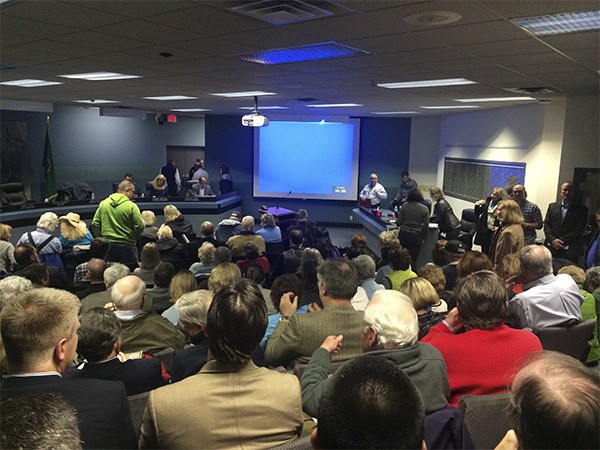Reporting for this article took place at a meeting after the Reporter deadline. A different version of this story, “New construction may be put on hold,” will run in Wednesday’s print edition of the Mercer Island Reporter.
In front of a full house, the Mercer Island City Council established a four-month moratorium on new construction downtown – but it exempts buildings under two stories and the proposed Hines mixed-use development in the heart of Town Center.
Pressure on the decision came from a group of residents and supporters of ‘Save our Suburbs’ (SOS), who want to evaluate the impacts of increased density before moving forward with new projects, and from developers who said that a moratorium could negatively impact plans to bring retailers like Pagliacci Pizza and Whole Foods to the Island and create a vibrant downtown village.
SOS supporters argued that growth in the Town Center affects the whole Island and could overload Island infrastructure, roads and schools. They urged the Council to consider a moratorium while the city continues the Comprehensive Plan and Town Center design processes that were started last year.
City officials held an open house on Jan. 29 to discuss the Comprehensive Plan update, Town Center visioning and preparation for Sound Transit’s light rail – all of which have potential to significantly change the North-end of Mercer Island.
The issue of a moratorium was discussed at the Council’s planning session on Jan. 23 and placed on the agenda for their Feb. 2 meeting. It passed 6-1, with Councilmember Mike Cero voting against it because it exempts Hines.
Moratoria are used by land-use planners to preserve the status quo while formulating a more permanent development strategy. Mercer Island’s moratorium will be imposed “on the submission or acceptance of applications for any building permits or any other land development permits or approvals for major new construction (in the) Town Center zone” for four months on buildings over two stories. This means that other projects, like a new Pagliacci Pizza location, will be able to move forward with permitting.
More than 100 people attended the Feb. 2 Council meeting. About 35 addressed the Council during public comments, including residents – almost all of whom were in support of a moratorium – as well as business owners and a Hines developer who read a letter from Whole Foods indicating interest in an Island location.
Tom King, who owns the property on which Hines will be built, said that the developer is responsible and community-oriented. Deputy Mayor Dan Grausz said that he didn’t want the city to “put a cool blanket” on projects like Hines that can provide something that many community members want.
“If opportunity is out there and we do something to kill it, a lot of people on the Island might be mad,” Grausz said.
Cero said that the anxiety caused by the Hines massing study photo was why the Council was having the discussion in the first place, and that exempting it from a moratorium would be counterproductive. Other Councilmembers said that seeming to target one project could open the city up to a lawsuit.

Grausz said he was also concerned about the photo when he first saw it and thought it looked like a “Fort Knox” in the middle of Town Center, but that it’s a massing study, not a design for the building.
Development Services Director Scott Greenberg said that he wasn’t aware of any projects besides Hines that are over two stories and in the pipeline in the next four months, leaving residents to wonder to which projects the moratorium will apply. But the four-month deadline closely mirrors the timelines for the Comprehensive Plan update and Town Center visioning, and the duration of the moratorium can be extended with another vote.
Many residents in attendance left the meeting in frustration when conversations about exempting Hines began.
“A large group of attendees, who stayed for about four hours, stood up and left after the moratorium became so watered down it was meaningless,” said SOS group leader Tom Acker.

Acker said that “the goal of the moratorium is only to slow the process down long enough to make sure there is proper definition in the codes to protect the community’s interests.”
He said that residents have been receiving emails from a Hines developer stating that “a moratorium would stop our project, causing the city to lose a civic plaza, public parking and potentially an upscale grocery store.”
“If the tradeoff is a specialty grocer versus increased density, then I would submit the Island may want to forego a Whole Foods,” Acker said.
Islanders were encouraged by both sides to write letters to City Councilmembers, who want to know what Islanders think.
The open house was a first step in a new public outreach process that aims for greater transparency and communication with citizens.
“There’s been a lot of public interest in this, which is a good thing,” said Mayor Bruce Bassett. “Public outreach and involvement will happen regardless of whether there’s a moratorium.”
A public hearing on the moratorium will be scheduled for 7 p.m. on March 2.
The open house also focused on the issue of providing commuter parking, with the impending closure of the South Bellevue Park and Ride and arrival of light rail.
Hines developers said they could provide more than 200 commuter parking spaces in exchange for an extra story. The current maximum number of stories allowed is five, which some Islanders feel is already too high.
Phase two of the Town Center visioning process is beginning soon, and involves more public outreach to determine what Islanders want to see in their downtown. The Comprehensive Plan update is set to be adopted on June 30.

